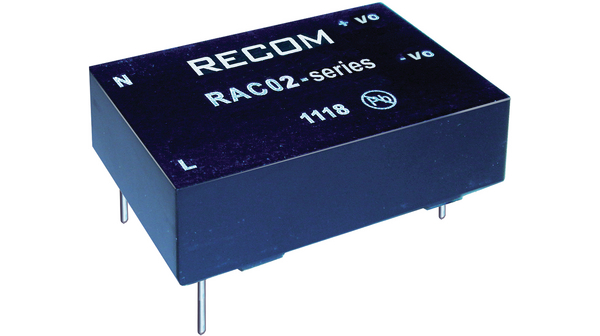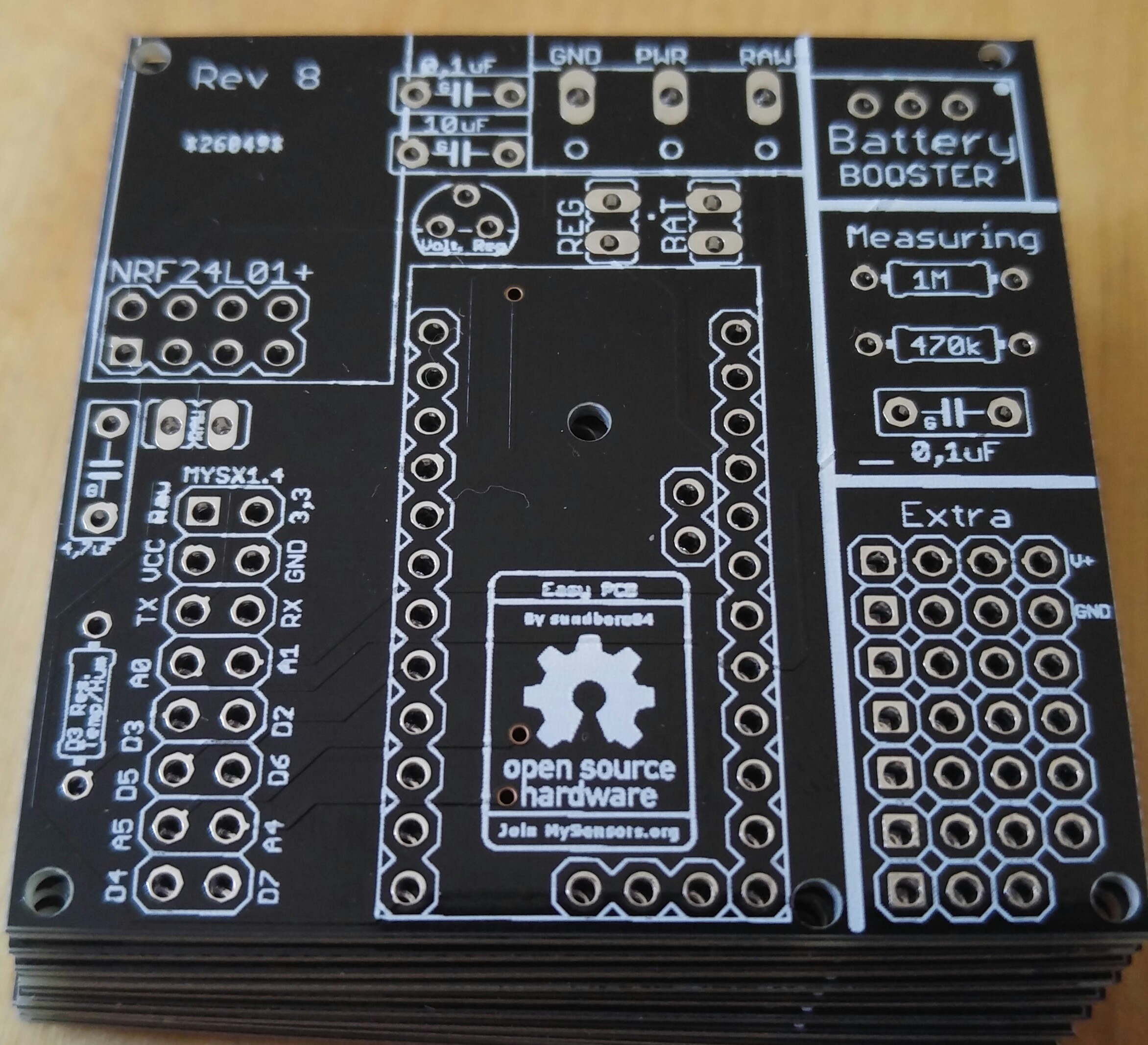💬 Easy/Newbie PCB for MySensors
-
Just wanted to say that my first sensor on this board works great! Measuring passives in place. Worked first try.
On battery, with booster and one DS18B20 temperature sensor.Great work @sundberg84!
-
@sundberg84: I have plan to use your pcb to build ethernet gateway, thus I want to use NRF24L01+ radio with external antenna. In this case it's more than recommended to use external power to supply the radio as pro mini has not enough juice to feed radio properly. Could you please give me some hint how to do it in most elegant way? I think it should be enough to do not solder radio's vcc and gnd pins to pcb, but to connect external power supply to these pins with hardsoldered capacitor. What do you think?
-
@sundberg84: I have plan to use your pcb to build ethernet gateway, thus I want to use NRF24L01+ radio with external antenna. In this case it's more than recommended to use external power to supply the radio as pro mini has not enough juice to feed radio properly. Could you please give me some hint how to do it in most elegant way? I think it should be enough to do not solder radio's vcc and gnd pins to pcb, but to connect external power supply to these pins with hardsoldered capacitor. What do you think?
@fisher - that is exactly what I did... i made a external "powerpcb" which i could connect the radio to and the node (Arduino + Ethern module) to. This way I didnt feed the radio from the arduino. Be sure to use a voltage regulator with a good ampere output.
Check this: https://www.openhardware.io/view/207/Mysensors-20-ethernet-gateway-W5100-build
-
@sundberg84: thx for the quick response. I saw your post with external ethernet gateway but I'd like to avoid use of jumper wires and use your newbie psb instead
-
@sundberg84: thx for the quick response. I saw your post with external ethernet gateway but I'd like to avoid use of jumper wires and use your newbie psb instead
@fisher - well, the only option then is to use a 3.3v arduino on my PCB and BAT jumper. Then make sure you have a steady 3.3v on PWR on the PCB. If you have any units (like ethernet module?) that needs 5v you need a step up for this... i guess there are many ways to solve this but I have not tried them so you need to experiment a little.
-
@sundberg84: I think I have to abandon my idea to use Newbie PCB as there is slightly different wiring required for connecting w5100 module. I will solder it on prototype board instead. Thanks for your help
-
@ar91 This is not my upload, but it looks right.
Its not the latest Rev 7 but it Rev6 was working so I think its safe to order.If you wait and order from my upload you are also contributing to MySensors as i will donate that small amount that goes to the author when buying.
@sundberg84
I really like this design. Do you have plans to make a version for the RFM69W radio? Shouldn't be to difficult but with the free version of eagle, I can't edit your design. :unamused: -
@sundberg84
I really like this design. Do you have plans to make a version for the RFM69W radio? Shouldn't be to difficult but with the free version of eagle, I can't edit your design. :unamused:@FotoFieber - that shouldnt be any problem editing. Do you try to open the gerber files, you need to open .sch and .brd
-
So I have one more flaw to point out in the board that I didn't notice before. I also have a question regarding powering the nano. I'll start with the problem and this is for @sundberg84 . Some weeks back I posted some suggestions and differences that I noticed in the revisions of the boards. This was the pic:

When I posted that, you noted that for the capacitors, the G denotes ground. If you look at the blue board on the right which is the one that I have, you have the G marked on the left leg of the capacitor. If you measure continuity from that pin to the large ground tab for incoming power, you will notice that that is not ground. The one on the right is. Since I got the boards, I have always teeted for continuity for my ground legs, so I haven't had any issues, but for a newbie, which is what the board is geared toward, there could be issues.Now on to my question regarding power. So I am building another node and I am using the 5 volt version of a Recom power module
 .
.
Seeing that this is a 5 volt output, I would think I should be able to go directly to the 5 volt in on the nano, but what is the best way to wire this if I am using a screw terminal connector to bring my power in? The RAW power pad goes to the regulator input on the nano, and the PWR pad goes to the battery booster which I am not using. I would also guess that I would need to jumper the BAT pads. Would I then too want to remove the regulator from the nano, or won't that matter?Any help is appreciated.
-
So I have one more flaw to point out in the board that I didn't notice before. I also have a question regarding powering the nano. I'll start with the problem and this is for @sundberg84 . Some weeks back I posted some suggestions and differences that I noticed in the revisions of the boards. This was the pic:

When I posted that, you noted that for the capacitors, the G denotes ground. If you look at the blue board on the right which is the one that I have, you have the G marked on the left leg of the capacitor. If you measure continuity from that pin to the large ground tab for incoming power, you will notice that that is not ground. The one on the right is. Since I got the boards, I have always teeted for continuity for my ground legs, so I haven't had any issues, but for a newbie, which is what the board is geared toward, there could be issues.Now on to my question regarding power. So I am building another node and I am using the 5 volt version of a Recom power module
 .
.
Seeing that this is a 5 volt output, I would think I should be able to go directly to the 5 volt in on the nano, but what is the best way to wire this if I am using a screw terminal connector to bring my power in? The RAW power pad goes to the regulator input on the nano, and the PWR pad goes to the battery booster which I am not using. I would also guess that I would need to jumper the BAT pads. Would I then too want to remove the regulator from the nano, or won't that matter?Any help is appreciated.
@dbemowsk - thanks for your unput! I have checked my project and changed the G label.
I will also make an notise on openhardware!You should be able to use that just fine as power. Most people here use HLK-PM01 but this might be a great addition! (Havent seen it before).
Check this thread out: https://forum.mysensors.org/topic/1607/safe-in-wall-ac-to-dc-transformers. You should connect it to PWR and GND with REG jumper short. -
@dbemowsk - thanks for your unput! I have checked my project and changed the G label.
I will also make an notise on openhardware!You should be able to use that just fine as power. Most people here use HLK-PM01 but this might be a great addition! (Havent seen it before).
Check this thread out: https://forum.mysensors.org/topic/1607/safe-in-wall-ac-to-dc-transformers. You should connect it to PWR and GND with REG jumper short.@sundberg84 said:
this might be a great addition! (Havent seen it before).Unfortunately it's not the same price range as HLK with 12$95 from all suppliers linked from their website.
Could still have been nice if it had "physical" advantages compared to HLK but it's bigger and with lower power.
So it's got the safety of a German product left, but HLK is safe enough provided we get a genuine one.Interesting part is the recommended circuit which is similar to the one suggested here for the HLK with input fuse, varistor for use with 230V source and optionnal output capacitor to reduce ripple. No temperature fuse but I suppose with bigger size, lower power and higher quality components it's getting really overkill.
-
I ended up ordering 3 of these. I got them from this site. It wasn't till after I ordered them that I saw a post on here about the HLK-PM01 modules. I see the better advantages of the HLK series, cost being the big one, and will order these in the future as needed, but I am just trying to use up the 3 of these that I have.
I have another project I am working on where I might order some HLK-PM12 modules. I ended up getting a lot of 10 - 12 or 24 volt relay modules for free that I figure I can use in some projects. I wish they were 5 volt, but it's hard to argue with FREE.
-
@fabix68 Your problem might be in the fact that the 18650 battery is a 3.7 volt battery, where the CR2032 is only a 3 volt. The extra 0.7 volts will make all the difference. If you use a CR2032, there are a few things you want to do. The first thing is that you need a battery booster. This will boost your power from 3 volts to the needed 3.3 for the nano and the radio. Next is to remove the LED from your nano. This will put unnecessary load on your battery and drain it much faster. You may even want to remove the regulator from the nano.
-
What are your setup @fabix68 ? If you are using a 3.3v arudino straight on it will not work.
Please describe your setup and hardware and not only your battery, -
I'm using Arduino mini pro 3.3v to which I removed led and regulator, battery boster and tamper on batt.
I attach the photo

@fabix68 should work just fine.
Whats your issue? Any serial output?

